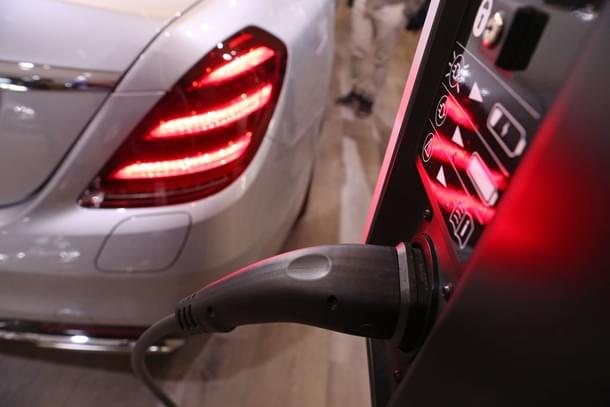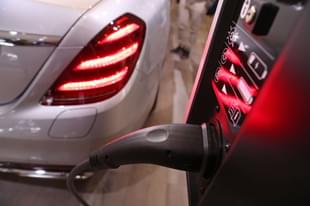Infrastructure
Swappable Batteries: A Game-Changing Alternative Or A Viable Auxiliary In EV Infrastructure?
Abhishek Nath Tripathi
Jul 15, 2018, 04:27 PM | Updated 04:27 PM IST
Save & read from anywhere!
Bookmark stories for easy access on any device or the Swarajya app.


Batteries hold the key in the battle between electric vehicles (EVs) and fossil fuel-based conventional vehicles (CV). The battery cost, charging efficiency and range are the three key factors which impact the competitiveness of EVs against CVs. While range issues can only be addressed through technological innovation, issues surrounding cost and charging efficiency can arguably be addressed by segregating battery from the rest of the EV, in its ownership and charging mechanism. On paper, swappable batteries hold game changing potential for the EV ecosystem. In a November 2017 blogpost, even Asian Development Bank strongly advocated swappable batteries for the Indian EV market. However, the enthusiasm around swappable batteries comes with doubts about its commercial viability.
Swappable batteries can potentially reduce the EV cost significantly if the EV owner is not the owner of the battery. By splitting the ownership of the vehicle from the batteries, the upfront cost of EVs can be significantly brought down, as batteries constitute amongst the most expensive components of an EV. In such case, EV owner will merely be paying for the charge that it receives in a fully charged battery and a leasing fee for leasing the battery for use.
Leasing fee will ideally include, besides return on investment, (i) the cost of the battery ammortised over its lifetime, (ii) the cost of the swapping infrastructure, (iii) the cost of the inventory that the battery owner will need to maintain, and (iv) insurance cost of the batteries (including the inventory) against damage, theft and other loss. The battery owner may charge a combined price linked to the effective capacity supplied, however such price will effectively need to take into account the charged capacity supplied, and the other fixed costs of the battery owner. The experience of Better Place, a US-based startup that attempted establishing battery swapping facilities, showed that a facility that is cost efficient for the consumer may cost dearly to the entrepreneur. Battery weight necessarily means that the process of swapping will need to be a mechanical process, as the owner is unlikely to be able to pull out the battery himself/herself and replace it. The cost of mechanical or robotic swapping infrastructure may, in fact, be significant.
In addition, if swapping is to become a principal source of charging, then the battery owner will need to maintain a significantly large inventory, as swapping is premised on the assumption that it is more time effective. The larger the inventory, the higher will be the cost to the consumer. Rapid growth in the battery and charging technology in the recent years means that the battery owner will shoulder higher risk of inventory obsoleteness. This would necessarily mean that the battery owner will be incentivised to ammortise the inventory cost over lesser years, thereby increasing the charging price to the consumer. On the other hand, the operator of the swapping facility will face the pressure of keeping the cost of charged batteries low enough to keep it competitive against charging of the battery from a charging facility.
There is little doubt that with a proper mechanised system, battery swapping can be achieved in a time duration comparable to refueling the CVs, at least for now. This will be a massive improvement over current charging technologies that require batteries to be plugged into a charger for a considerably long time. EV enthusiasts argue that any car is usually parked idly for a long time, whether at homes or at parking lots in offices, which time can be used for charging the vehicle. This is a solution far from perfect, particularly when the vehicles have to be driven over long distances, or where parking areas do not offer sufficient charging infrastructure.
Swappable batteries may offer a solution to this problem but this comes with caveats. If battery ownership is distinct from EV ownership, the battery owner/s should have a large geographical presence. Further, either it must be the same battery owner that must operate multiple facilities, or different battery owners must agree to accept batteries owned by different owners in their swapping stations. Different batteries will have different life, and an owner accepting an older discharged battery against a newer charged battery that it supplies to the EV owner may not work, unless an efficient and trustworthy accounting mechanism is put in place between the owners of swapping facilities to account for different batteries exchanged at the swapping stations. The investment required for setting up such a large number of swapping stations coupled with the inventory cost may itself be the beginning of the end of the idea. The Better Place experiment folded up within a few years of its inception, arguably due to its high initial investment. As the charging technology makes progress, and charging becomes faster, swapping may lose its viability even further.
In addition, for battery swapping to succeed as a viable commercial idea, batteries will need to be standardised. This requires the EV manufacturers and original battery manufacturers to collectively agree to have standard batteries for EVs. This is easier said than done, as many EV manufacturers may not be happy foregoing their ability to control proprietary battery designs. EV design may also be affected by the battery design, and the EV manufacturer may want the freedom to design batteries to suit their EV design, rather than be tied to a standard design or make. Enforcing standardisation through regulatory intervention may not be the ideal approach, particularly when the technology is still evolving and is yet to stabilise.
Large scale charging of batteries at a single location, particularly high capacity batteries, also poses challenges for electricity utilities, as such swapping facilities will need extremely high load connections. For example, if a swapping station wishes to serve about 100 cars (with 30-35 KW batteries), a simple ball park assumption will require it to keep about 150 or more batteries on charge at any point in time. This will require swapping facility to have a sanctioned load of up to 4-5 MW. The utilities may not yet be ready to provide such load with the current transmission and distribution infrastructure.
Does this mean battery swapping has no future? Perhaps, it still has some relevance for EV driven public transport, where quick charging is a pressing need for vehicles constantly on the move. State utilities/public transporters operating large fleets may find the swapping technology a commercially viable proposition. Swapping facility for transport vehicles engaged in last mile connectivity with batteries of smaller capacity and size may also achieve viability, and it may have its use in emergency situations too. However, it will remain commercially viable only as a complementary service to charging infrastructures. Therefore, it will be prudent for policy makers to steer clear of the push for swapping facilities over charging facilities. In the short run, the demand for swapping, however, may produce a unicorn with a novel business model for swapping.
Also read: The Burning Question About Electric Vehicles – What Kind Of Batteries Do We Use?
Abhishek Tripathi is a corporate lawyer, and a Senior Partner at Sarthak Advocates & Solicitors. He advises extensively on energy and infrastructure laws, and has worked on several projects across various jurisdictions in Asia and Africa.




